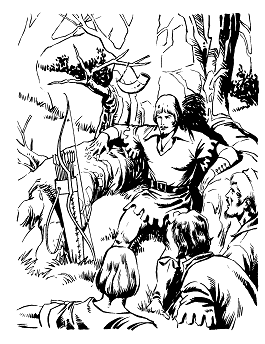
Robin Hood is a legendary heroic outlaw originally depicted in English folklore and subsequently featured in literature and film. According to legend, he was a highly skilled archer and swordsman. In some versions of the legend, he is depicted as being of noble birth, and in modern retellings he is sometimes depicted as having fought in the Crusades before returning to England to find his lands taken by the Sheriff. In the oldest known versions, he is instead a member of the yeoman class. Traditionally depicted dressed in Lincoln green, he is said to have robbed from the rich and given to the poor.

Little John is a companion of Robin Hood who serves as his chief lieutenant and second-in-command of the Merry Men. He is one of only a handful of consistently named characters who relate to Robin Hood and one of the two oldest Merry Men, alongside Much the Miller's Son. His name is an ironic reference to his giant frame, as he is usually portrayed in legend as a huge warrior – a 7-foot-tall (2.1-metre) master of the quarterstaff. In folklore, he fought Robin Hood on a tree bridge across a river on their first meeting.

Sir Guy of Gisbourne is a character from the Robin Hood legends of English folklore. He first appears in "Robin Hood and Guy of Gisborne", where he is an assassin who attempts to kill Robin Hood but is killed by him. In later depictions, he has become a romantic rival to Robin Hood for Maid Marian's love.

Maid Marian is the heroine of the Robin Hood legend in English folklore, often taken to be his lover. She is not mentioned in the early, medieval versions of the legend, but was the subject of at least two plays by 1600. Her history and circumstances are obscure, but she commanded high respect in Robin’s circle for her courage and independence as well as her beauty and loyalty. For this reason, she is celebrated by feminist commentators as one of the early strong female characters in English literature.
Much, the Miller's Son is one of the Merry Men in the tales of Robin Hood. He appears in some of the oldest ballads, A Gest of Robyn Hode and Robin Hood and the Monk, as one of the company.
Will Scarlet is a prominent member of Robin Hood's Merry Men. He is present in the earliest ballads along with Little John and Much the Miller's Son.

Adam Bell was a legendary English outlaw. He and his companions William of Cloudsley and Clym of the Clough lived in Inglewood Forest near Carlisle and were figures similar to Robin Hood. Their story is told in Child Ballad 116 entitled Adam Bell, Clym of the Cloughe and Wyllyam of Cloudeslee. The basis of the tale has historical roots in the criminal activities of the Folville and Coterel gangs. At one point William of Cloudsley, who is famed as an archer, shoots an arrow through an apple on his son's head at six score paces, a feat also ascribed to William Tell and other heroes. The oldest printed copy of this ballad dates from 1505 and was printed by Wynkyn de Worde. There are notable parallels between this ballad and that of Robin Hood and the Monk, but whether either legend was the source for the other cannot be established.

The Merry Adventures of Robin Hood of Great Renown in Nottinghamshire is an 1883 novel by the American illustrator and writer Howard Pyle. Pyle compiled the traditional Robin Hood ballads as a series of episodes of a coherent narrative. For his characters' dialog, Pyle adapted the late Middle English of the ballads into a dialect suitable for children. The novel is notable for taking the subject of Robin Hood, which had been increasingly popular through the 19th century, in a new direction that influenced later writers, artists, and filmmakers through the next century.
Will Stutely or Will Stutly is in English folklore a prominent member of Robin Hood's Merry Men. He was possibly confused with Will Scarlet because of the similarities in their surnames.
"Robin Hood and the Curtal Friar" is Child Ballad number 123, about Robin Hood.
Robin Hood and the Tanner is Child ballad 126. It is a late seventeenth-century English broadside ballad and one of several ballads about the medieval folk hero Robin Hood that form part of the Child ballad collection, which is one of the most comprehensive collections of traditional English ballads but has now been subsumed and surpassed by the Roud Folk Song Index.
Robin Hood and the Butcher is a story in the Robin Hood canon which has survived as, among other forms, a late seventeenth-century English broadside ballad, and is one of several ballads about the medieval folk hero that form part of the Child ballad collection, which is one of the most comprehensive collections of traditional English ballads. It may have been derived from the similar Robin Hood and the Potter.
Robin Hood's Golden Prize is Child ballad 147. It is a story in the Robin Hood canon which has survived as, among other forms, a late seventeenth-century English broadside ballad, and is one of several ballads about the medieval folk hero that form part of the Child ballad collection, which is one of the most comprehensive collections of traditional English ballads.

A Gest of Robyn Hode is one of the earliest surviving texts of the Robin Hood tales. Gest is a compilation of various Robin Hood tales, arranged as a sequence of adventures involving the yeoman outlaws Robin Hood and Little John, the poor knight Sir Richard at the Lee, the greedy abbot of St Mary's Abbey, the villainous Sheriff of Nottingham, and King Edward of England. The work survives only in printed editions from the early 16th century; just some 30 years after the first printing press was brought to England. Its popularity can be estimated from the fact that portions of more than ten 16th- and 17th-century printed editions have been preserved. Written in late Middle English poetic verse, Gest is an early example of an English language ballad, in which the verses are grouped in quatrains with an abcb rhyme scheme.
Little John A Begging is Child ballad 142 and about Robin Hood. It exists in two variants, one fragmentary.

Robin Hood and the Monk is a Middle English ballad and one of the oldest surviving ballads of Robin Hood.
The Bold Pedlar and Robin Hood is Child ballad 132, featuring Robin Hood. It is a traditional version of Robin Hood Newly Revived.

The Merry Men are the group of outlaws who follow Robin Hood in English literature and folklore. The group appears in the earliest ballads about Robin Hood and remains popular in modern adaptations.

Robin Hood and Little John is Child ballad 125. It is a story in the Robin Hood canon which has survived as, among other forms, a late seventeenth-century English broadside ballad, and is one of several ballads about the medieval folk hero that form part of the Child ballad collection, which is one of the most comprehensive collections of traditional English ballads.








